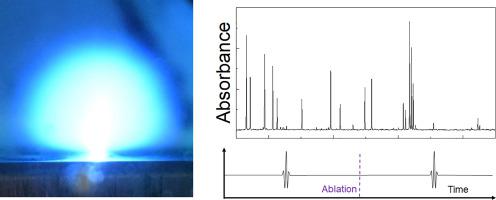Spectrochimica Acta Part B: Atomic Spectroscopy ( IF 3.2 ) Pub Date : 2021-05-13 , DOI: 10.1016/j.sab.2021.106199 Reagan R.D. Weeks , Mark C. Phillips , Yu Zhang , Sivanandan S. Harilal , R. Jason Jones

|
The oscillator strengths of 43 transitions of neutral gadolinium from 530 to 535 nm were determined based on high-resolution absorption spectra measured by probing a laser-produced plasma using time-resolved dual-comb spectroscopy. Absorption spectra were measured at various time delays, ranging from 33 to 252 μs after the onset of the plasma formation, over which the temperature and number density varied as the ablation plume evolved. A Boltzmann analysis was used to determine the excitation temperature and column density of Gd in the ablation plume, based on measured absorption from 20 Gd I spectral lines with known oscillator strengths. Oscillator strengths were then determined for additional dipole-allowed Gd I transitions identified in the absorption spectra, 19 of which were previously unreported. Oscillator strengths of all measured transitions were compared with literature values when available and show good agreement in most cases. Time-resolved measurement of atomic absorption in the cooling plasma provides access to a range of excitation temperatures and optical densities for the atoms in the ablation plume, allowing repeated measurements under different conditions, thereby improving confidence in the results. Our results also highlight that the high spectral bandwidth and resolution capabilities of dual-comb spectroscopy make it well-suited to measuring the dense optical spectrum of Gd, and the technique is applicable to other elements, especially lanthanides and actinides.
中文翻译:

在激光产生的等离子体中使用双梳状吸收光谱法测量中性oscillator振荡器的强度
基于高分辨率吸收光谱,确定了中性to从530到535 nm的43个跃迁的振荡器强度,该高分辨率吸收光谱是通过使用时间分辨双梳光谱仪探测激光产生的等离子体而测得的。在等离子体形成开始后的33到252μs的各种时间延迟下测量吸收光谱,在此期间温度和数量密度随消融羽流的发展而变化。基于从具有已知振荡器强度的20条Gd I谱线测得的吸收,基于玻尔兹曼分析法确定了消融羽流中Gd的激发温度和柱密度。然后确定在吸收光谱中确定的其他偶极子允许的Gd I跃迁的振荡器强度,其中19个以前未报道。在可获得的情况下,将所有测得的跃迁的振荡器强度与文献值进行比较,并且在大多数情况下显示出很好的一致性。冷却等离子体中原子吸收的时间分辨测量可提供一定范围的激发温度和烧蚀羽流中原子的光密度,从而允许在不同条件下进行重复测量,从而提高了结果的可信度。我们的结果还突出表明,双梳状光谱仪的高光谱带宽和分辨能力使其非常适合于测量Gd的密集光谱,并且该技术适用于其他元素,尤其是镧系元素和act系元素。冷却等离子体中原子吸收的时间分辨测量可提供一定范围的激发温度和烧蚀羽流中原子的光密度,从而允许在不同条件下进行重复测量,从而提高了结果的可信度。我们的结果还突出表明,双梳状光谱仪的高光谱带宽和分辨能力使其非常适合于测量Gd的密集光谱,并且该技术适用于其他元素,尤其是镧系元素和act系元素。冷却等离子体中原子吸收的时间分辨测量可提供一定范围的激发温度和烧蚀羽流中原子的光密度,从而允许在不同条件下进行重复测量,从而提高了结果的可信度。我们的结果还突出表明,双梳状光谱仪的高光谱带宽和分辨能力使其非常适合于测量Gd的密集光谱,并且该技术适用于其他元素,尤其是镧系元素和act系元素。











































 京公网安备 11010802027423号
京公网安备 11010802027423号